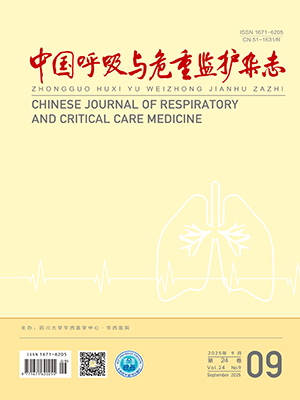【Abstract】 Objective To evaluate the relationship between multiple tumor biomarkers and idiopathic pulmonary fibrosis ( IPF) , and analyze the prognostic value of these biomarkers in IPF. Methods Clinical data of 43 confirmed IPF patients with no evidence of malignant disaeses, admitted in Peking Union Medical College Hospital between January 2000 and June 2010, were retrospectively analyzed. All IPF patients had detected serum alpha fetoprotein ( AFP) , cancer antigen 50 ( CA50) , cancer antigen 24-2( CA24-2) , carcinoembryonic antigen ( CEA) , carbohydrate antigen 19-9 ( CA19-9) , cancer antigen 125( CA125) , cancer antigen 15-3 ( CA15-3) , tissue polypeptide antigen ( TPA) , neuron specific enolase( NSE) , and cytokeratin-19-fragment ( Cyfra211) . Results The serum levels of CEA, CA19-9, CA125,CA15-3, and TPA were obviously higher than normal range, while the serum levels of AFP, CA50, CA24-2,NSE, and Cyfra211 were within normal range. Neither tumor biomarkers had correlation with 6-minute walk distance, FVC% pred, TLC% pred, DLCO/VA, PaO2 , PaO2 /FiO2 , P( A-a) O2 , BALF cell differentiation counting,or CD4 /CD8. The patients with increased CA19-9 level had shorter survival time than those with normal CA19-9 level ( P lt; 0. 05) . There was no significant difference in survival time between the patients with increased CEA/TPA levels and those with normal CEA/TPA levels( P gt;0. 05) , neither between the patients with glucocorticoid treatment and those with non-glucocorticoid treatment ( P gt; 0. 05) . Conclusions Multiple tumor biomarkers, especially CA19-9, increase in IPF patients. The degrees of those increases are
not associated with the severity of disease, but closely relate to prognosis, and may also indicate the progression. The increases of multiple tumor biomarkers may be a sign of poor prognosis of IPF with no evidence of malignant disaeses.
Citation: CHAI Jingjing,LIU Tao,CAI Baiqiang,GUO Zijian. The Relationship Between Tumor Biomarkers and Idiopathic Pulmonary Fibrosis. Chinese Journal of Respiratory and Critical Care Medicine, 2011, 10(1): 38-41. doi: Copy
Copyright © the editorial department of Chinese Journal of Respiratory and Critical Care Medicine of West China Medical Publisher. All rights reserved




